Ready to inject some yoga into your life? Before you go to your first yoga class or start a home-based program, here are some essential yoga poses for beginners to get you started with confidence.
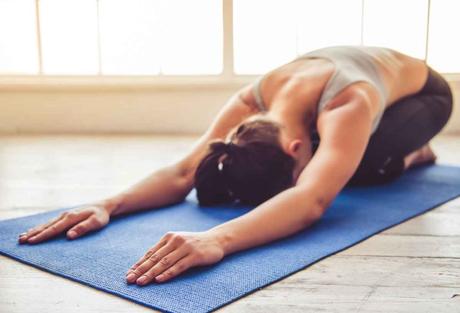
You’ve decided to check out what the hype is and start doing yoga.
Grabbing your yoga mat, you are motivated and stoked about yoga’s benefits, but where do you start?
Beginning a yoga practice can be intimidating, whether it’s going to your local studio or following a video in your living room.
To help ensure you develop a safe, effective and enjoyable practice, learning the ins and outs of some of the fundamental poses is essential.
In this guide, we will look at my favorite yoga poses for beginners.
Let’s jump right in and get our namaste on!
Why Should You Do Yoga?
Yoga has many benefits physically, mentally, and emotionally.
The practice focuses on strengthening the mind-body connection, which can improve self-awareness, sharpen focus, reduce stress and improve your overall wellness.
Some of the most common physical benefits people experience include improved mobility, strength, body awareness, and a greater ability to relax.
The Different Types of Poses
There are many different poses, but most fall into some general categories.
First is the position you perform the pose in, which includes standing, seated, kneeling, prone, supine and balancing. Different categories of poses in these positions include; forward bends, hip openers, twists, inversions and restorative poses.
Taking from these categories the following 10 yoga poses are essential for beginners to learn and will teach you the fundamentals you need to develop a strong practice.
These poses are involved in different variations of a sun salutation.
10 Essential Yoga Poses for Beginners
Pose #1: Mountain – Standing
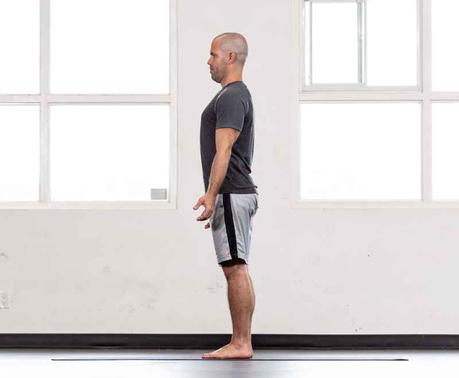
Benefits:
- Improves posture
- Develops body awareness
- Sets the foundation for all standing poses
Cues:
- Come to a strong standing posture
- Place your feet hip distance apart and pointed straight forward
- Feel into the four corners of your feet (big toe, little toe, inner and outers side of heels)
- Have the hips in a neutral position
- Slightly engage the core
- Feel your collar bones wide and relax your shoulders
- Lengthen the neck bringing the earlobes over your shoulders
- Relax the arms at the sides of the body with the palms facing forward
Common Errors:
- Feet are turned outwards
- Knees are locked
- Hips are tipped forward or back
- Shoulders are rounded
- Neck is shortened
Pose #2: Standing Forward Fold – Forward Bend
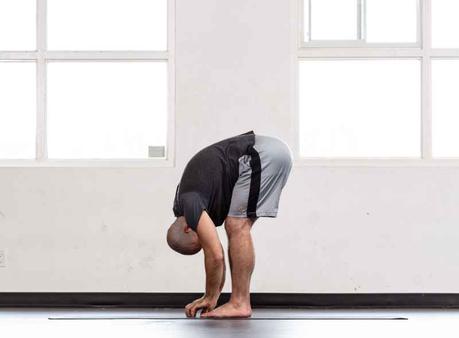
Benefits:
- Increases hip mobility
- Allows the neck and back to relax
- Stretches the hamstrings
Cues:
- Start in mountain pose
- On an inhale raise your arms out the sides and then up and overhead
- On an exhale leading with your chest, keeping a strong core and your spine long bring your arms out to the side as you fold forward hinging at your hips
- Bend your knees enough that your upper body is coming close to or onto your thighs
- Allow your head to hang and your neck to relax
Common errors:
- Knees are locked
- Bending through the back rather than initiating the movement at the hips
- Legs are extended to a point where the upper body is far away from the thighs
Pose #3: Halfway Lift – Forward Bend
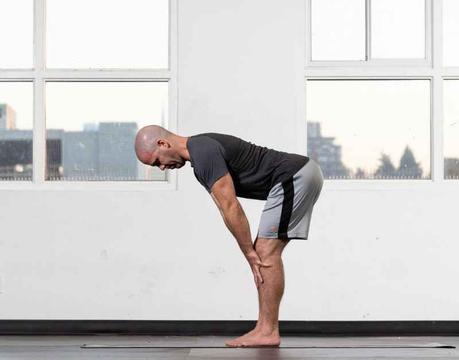
Benefits:
- Develops body awareness
- Lengthens the spine
- Improves posture
Cues:
- Start in a standing forward fold
- Place your hands on your shins
- On an inhale bring your torso halfway up so you have a 90° angle
- Look straight down at the ground so that your neck is in line with the rest of your spine
- Lengthen your spine and engage your core
Pose #4: Runner’s Lunge – Hip Opener
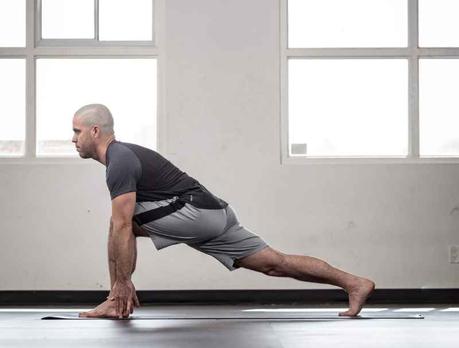
Benefits:
- Foundation for all other lunges
- Stabilizes your hips
- Stretches your hip flexors
Cues:
- Start in a standing forward fold
- Bend your knees enough that your hands reach the ground
- On an inhale bring your right foot back towards the back of the mat coming into a lunging position
- Point your left foot straight forward with your knee directly over your ankle
- Square your hips feeling:
- The front hip pull back and the back hip pull forward
- Without moving your feet feeling as if the front heel is coming towards your back toes and your back toes are coming towards your front heel
- Have both hip points facing forward like headlights
Common Errors:
- Hips are not squared
- Front knee is not lined up with the ankle
- Front foot is not pointed straight forward
Pose #5: High Lunge – Hip Opener
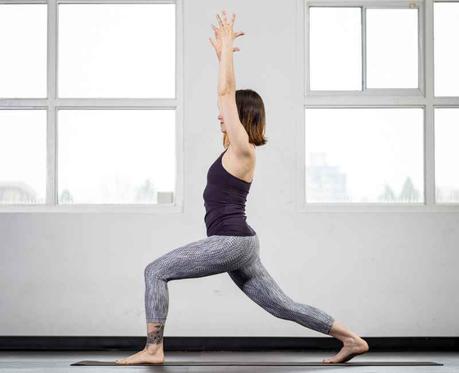
Benefits:
- Hip and shoulder mobility
- Core strength
- Body awareness
Cues:
- Start in a runner’s lunge
- Square your hips feeling as if your front hip is moving back and your back hip is moving forward
- Ensure your front foot knee and foot are pointed straight forward with your knee stacked over your ankle
- Have your back toes tucked under with the ball of your back foot down and pressing through the heel
- Come up onto your fingertips, raising your chest and lengthening your spine
- On an inhale with a strong core and long spine come up with the upper extending the arms overhead
- Bring your front need towards a 90° angle
Common Errors:
- Front foot is not pointed straight forward
- Front knee is in front of the ankle
- Front knee is not pointed straight forward
- Upper body is not in line with the hips
Pose #6: Plank – Prone
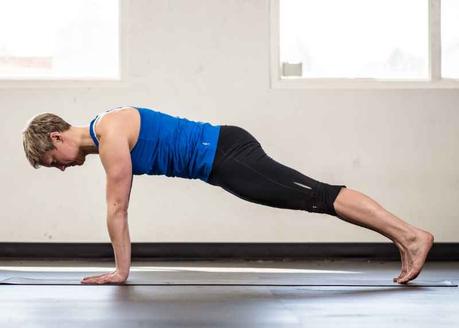
Benefits:
- Strengthens both the core and upper body
- Improves posture
- Sharpens focus
Cues:
- Start in table top (on your hands and knees with fingers spread wide and pointing forward)
- Externally rotate your shoulders. To do this keep your fingers facing forward and:
- turn your elbow creases to face forward
- twirl your triceps towards each other
- Keeping the shoulders directly over the elbows and the elbows over the wrists walk your knees back about a few inches
- Exhale engage the core
- Inhale bring the knees off of the ground bringing the legs towards straight engaging the glutes
- Ensure that there is active length in the spine and that the space between your shoulder blades is filled with your upper back
Common Errors:
- Fingers are not pointed straight forward
- Fingers are not spread wide
- The seat is lifted higher than the spine
- The spine is over arched
- Hands are wider or narrower than shoulder width
Pose #7: Chaturanga – Prone

Benefits:
- Strengthens the shoulders, chest, triceps and core
- Improves focus and resilience
Cues:
- Start in a plank
- On an exhale keeping your elbows tucked in towards your ribs and shoulders away from your ears slowly lower yourself down towards the ground
- Hover approximately two inches off of the ground keeping your core strong and spine long
Common Errors:
- Allowing the hips to drop
- Elbows are flared out away from the body
- Shoulders are behind the elbows and wrists
Pose #8: Cobra – Back Bend
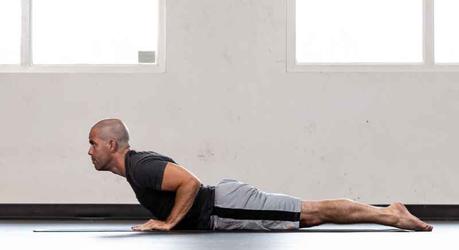
Benefits:
- Increases mobility in the spine, hips and shoulders
- Opens through the front of the body
- Stretches the abdominal muscles
Cues:
- Start by lying flat on your stomach
- Place your hands directly under your shoulders with your elbows tucked in towards your ribs
- On an exhale press the top of your feet into the ground engaging your quads and feeling your knees lift off the ground slightly
- On an inhale bring your shoulder blades towards your spine lifting your shoulders and widening your collar bones
- Press your hands into the floor gently lifting chest off of the ground to whatever extent is comfortable for your ROM
- If you feel any pain in your lower back come out of this pose
Common Errors:
- Shoulders are shrugged up towards the ears
- Feet are lifted off of the ground
- Quadriceps are not engaged
- Elbows move away from the body
- Coming into the pose too quickly
Pose #9: Down Dog – Forward Bend
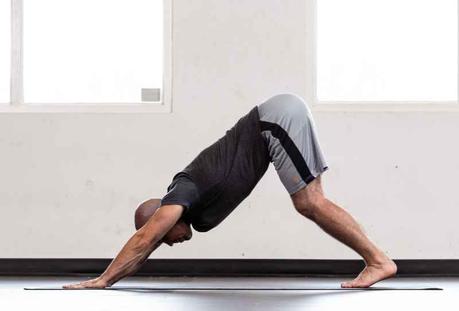
Benefits:
- Increases upper body strength
- Develops shoulder, hip and ankle mobility
- Stretches the hamstrings and calves
Cues:
- Start in a table top position (on your hands and knees)
- Walk your knees back or your hands forward a few inches
- Externally rotate your shoulders. To do this keep your fingers facing forward and:
- turn your elbow creases to face forward
- twirl your triceps towards each other
- On an exhale press the ground away from you staying connected to your shoulders bring your hips up and back into an inverted ‘V’ position
- Feel active length in the spine from the tailbone to the top of your head
- Keep your neck in line with the rest of the spine
- Press your sternum towards your thighs while keeping your shoulders strong and stable
- Work with your range of motion and lengthen your legs without forcing them towards straight
Common Errors:
- Shoulder joints are allowed to be unstable
- Shoulders are internally rotated
- Dropping the head
- Forcing the heels towards the ground
Pose #10: Savasana – Restorative
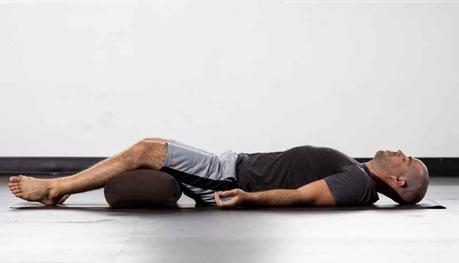
Benefits:
- Calming
- Relaxing
- Restorative
Cues:
- Start by lying flat on your back
- Extend your legs long on the ground just past hip distance allowing your hips possibly allowing the feet to drop out to the side
- Place your arms to either side of the body with the palms facing straight up towards the sky allowing the chest and shoulders to open
- Rest your head on the ground softening the neck and the muscles in your face
- Inhale deeply and exhale strongly and let go
Modifications:
- You can place a bolster under your knees
- You can cover your body with a blanket
- You can rest your head on a small foam yoga block or cushion
*If this is not a restful position for you, move into one that is.
The Bottom Line
After learning the ins and outs of these 10 poses you are now armed with the knowledge to step on the yoga mat with confidence.
You have started your journey towards developing a safe, effective, and enjoyable yoga practice.
Start with these moves, and work your way towards better physical, emotional, and mental health.
More Yoga Guides and Articles Like This
7 Benefits of Yoga for Athletes. Yoga is an effective tool for improving athletic performance, from recovery to increased range of motion. Here are seven reasons athletes should use yoga in their training for better performances at practice and in competition.
How Many Calories Does Yoga Burn? Wondering how effective yoga is as a means to lose weight? Here is a look at what types of yoga are best for burning calores and losing weight.
Yoga Burn – A Firsthand Review of This Popular Weight Loss Program. Yoga Burn is a proven and awesome way to lose weight and firm up your body. Here’s a firsthand review of this popular weight loss program.
